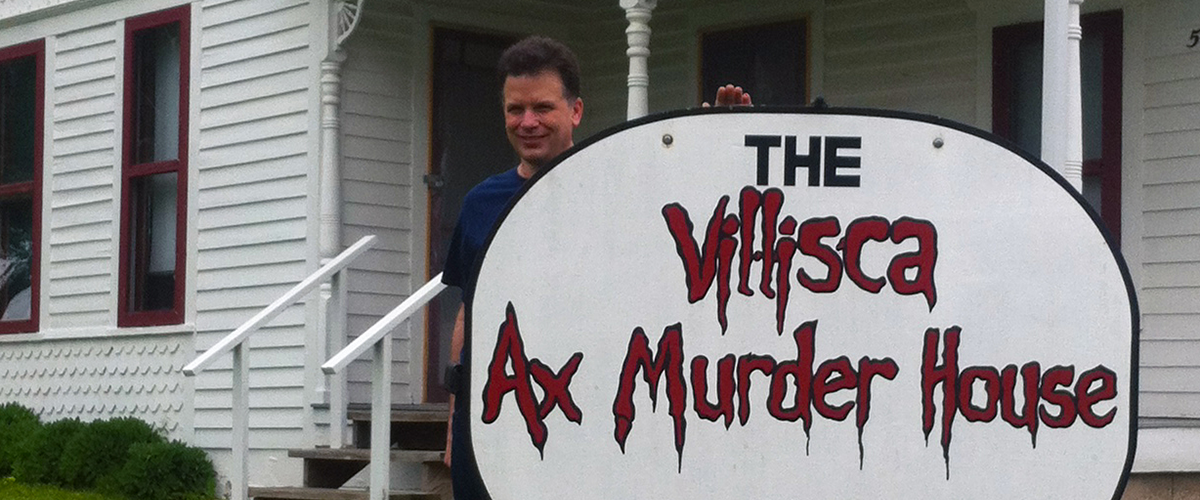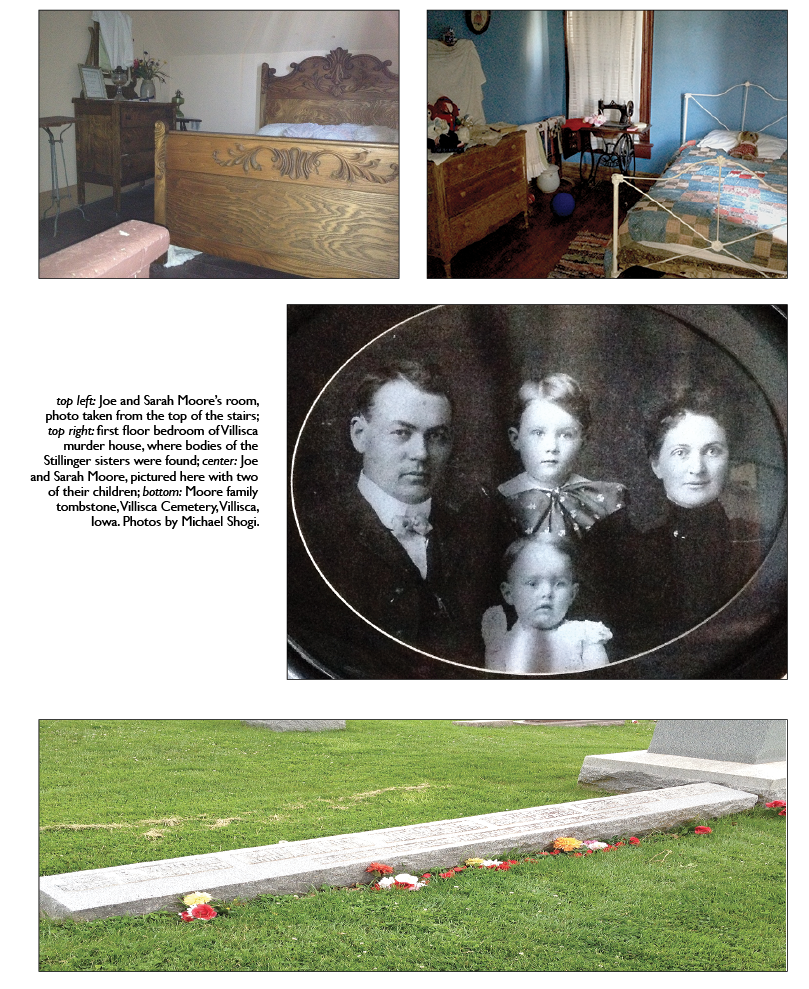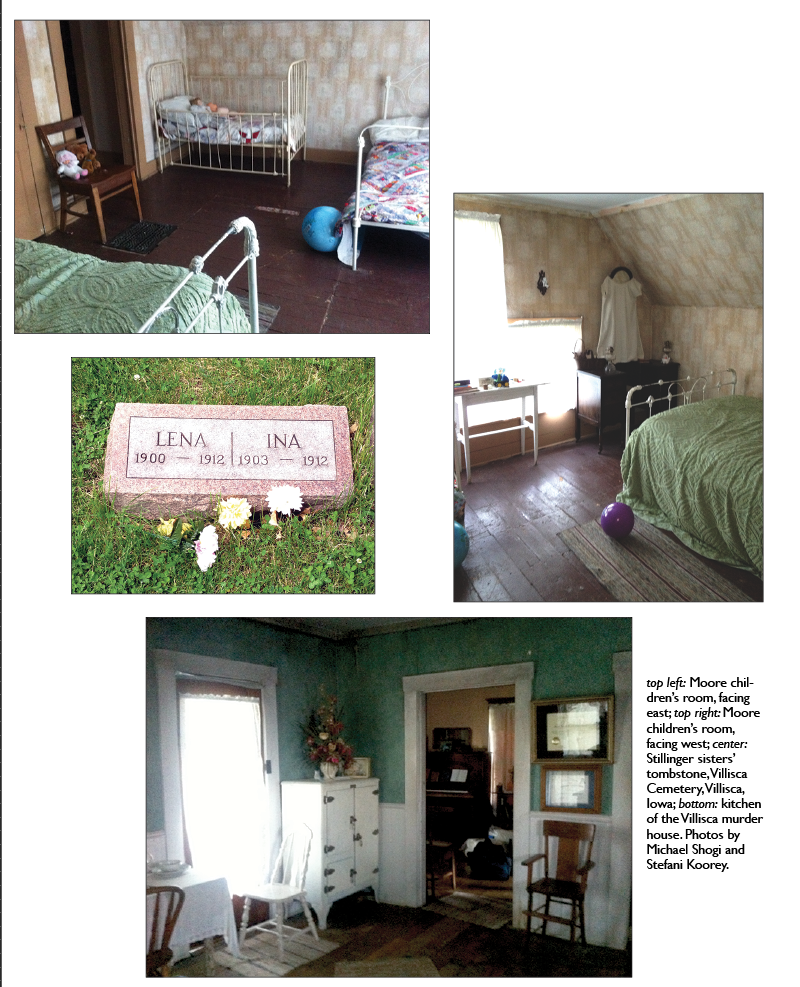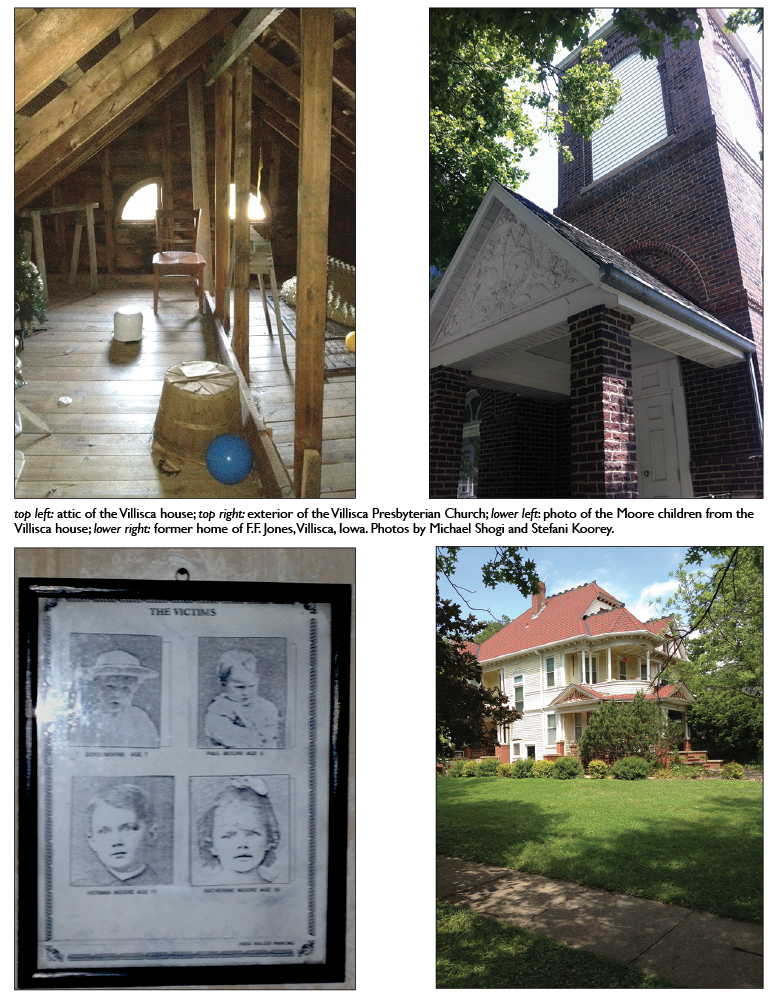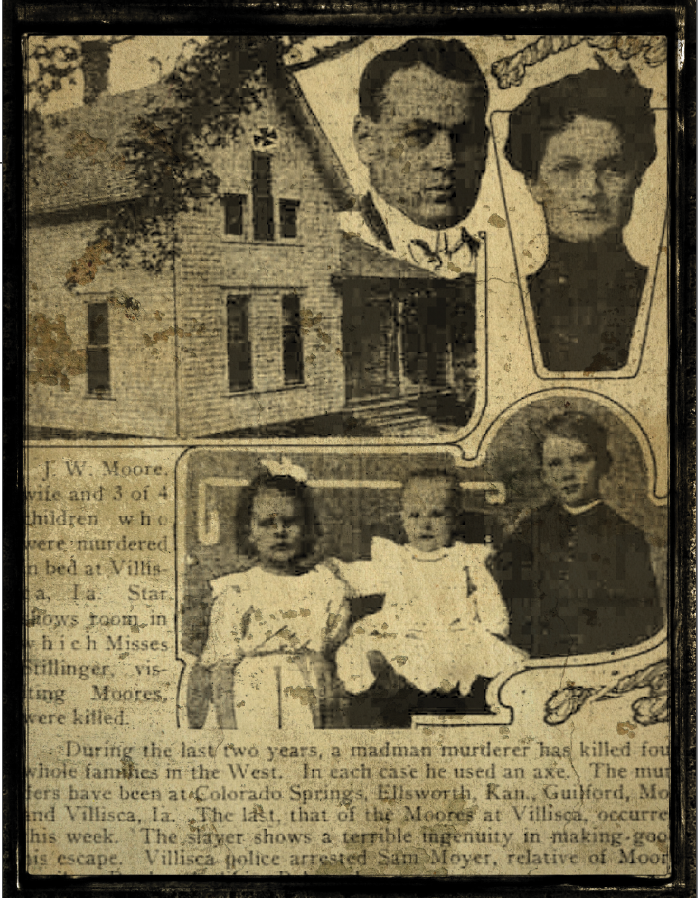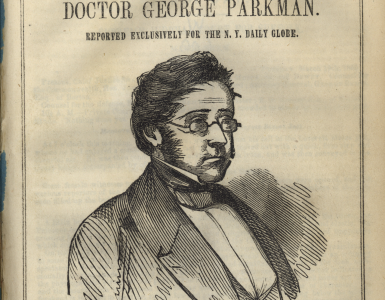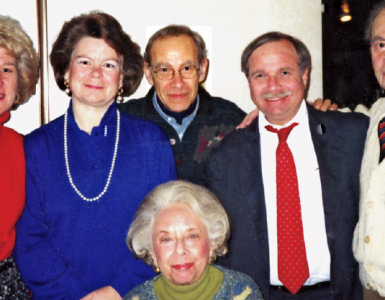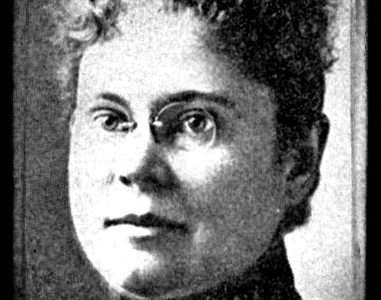by Michael Shogi
First published in Winter, 2013, Volume 8, Issue 1, The Hatchet: Journal of Lizzie Borden Studies.
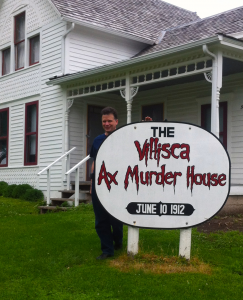 On June 4-5, 2012, Hatchet editor Stefani Koorey, fellow Bordenphile Don Sykes, and I traveled to the small farming community of Villisca, Iowa (population 1,345), to stay overnight in the infamous Villisca Axe Murder House. In this article, I will briefly discuss the crimes that occurred in Villisca during June 9-10, 1912, the primary suspects, what I learned from our trip, and who I believe most likely committed the crimes.
On June 4-5, 2012, Hatchet editor Stefani Koorey, fellow Bordenphile Don Sykes, and I traveled to the small farming community of Villisca, Iowa (population 1,345), to stay overnight in the infamous Villisca Axe Murder House. In this article, I will briefly discuss the crimes that occurred in Villisca during June 9-10, 1912, the primary suspects, what I learned from our trip, and who I believe most likely committed the crimes.
The Story . . . So Far
Villisca’s darkest night began on the evening of Sunday, June 9, 1912, when Josiah Moore (age 43) attended the annual Children’s Day Program at the Villisca Presbyterian Church. This Program, which Moore’s wife, Sarah (age 39) coordinated, provided the children of Church members with an opportunity to sing, read Bible passages, and perform short skits for members and their guests. The Moore children – Herman (age 11), Katherine (age 9), Boyd (age 7), and Paul (age 4) – participated in the Program, as did their friends, sisters Lena (age 11) and Ina Stillinger (age 8).
After the Children’s Day Program ended (around 9:30 p.m., Sunday evening), the Moore family and their overnight guests, the Stillinger sisters, walked three blocks to the Moore home, arriving around 10 p.m. What happened between 10 p.m., Sunday evening, and the following morning haunts Villisca, Iowa, to this very day.
At approximately 7 a.m., on Monday, June 10, the Moores’ next-door neighbor, Mary Peckham, noticed that the Moore family home was unusually silent, with shades drawn and chickens and horses unfed. Mary knocked on the door and, upon receiving no response, phoned Ross Moore, Joe’s brother, who quickly arrived at the Moore home to investigate. Around 8 a.m., when Ross used his key to open the front door, he found the Stillinger sisters slaughtered in the first floor bedroom. Ross immediately backed out of the house, refusing to climb the staircase to the second floor, where Joe and Sarah Moore’s bedroom was located a few feet away from that of their children. Rather, Ross Moore asked Mary Peckham to call Villisca City Marshall Hank Horton. When Horton arrived, he found the entire Moore family, along with the Stillinger sisters, bludgeoned to death in their beds—their bodies covered with sheets and their heads pulverized by a blunt-edged object.
Further investigation revealed that this object was the Moore family’s axe. The axe was found lying against the first-floor bedroom wall, along with two slabs of bacon—one against the same bedroom wall and one against the kitchen wall. A basin filled with bloody water, and a plate containing a small amount of food, were also discovered in the kitchen, and several oil lamps, with their chimneys removed, were placed throughout the house. In addition to the window shades being drawn, all mirrors in the Moore house were covered with sheets.
The townspeople of Villisca had never witnessed such carnage before, and their curiosity got the best of them. It is estimated that hundreds of people trampled through the Moore house, spoiling the crime scene, before the Villisca National Guard arrived to restore order. Bloodhounds were dispatched on Tuesday, June 11, and they were able to track a scent from the Moore House to the nearby Nodaway River, before losing the scent. No known photos of the crime scene survive, no usable fingerprints were taken, and the Villisca Axe Murders remain unsolved to this very day.
The Primary Suspects
The inability to secure a conviction for these heinous crimes was not for the lack of trying. In fact, legal proceedings were initiated against several people, one of whom even confessed to the murders.
Reverend George Kelly
Lyn George Jacklin Kelly (age 34 in 1912) was an itinerant preacher, who stood five feet two inches tall, weighed about 135 pounds, and, on a good day, was described as “eccentric” and “peculiar”. More accurately, Kelly was a pervert—a known “window peeper” and a probable pedophile, who would eventually be arrested for soliciting sex from an underage girl.
On the night of the murders, Kelly was the house guest of Pastor and Mrs. Wesley Ewing of the Villisca Presbyterian Church. Mrs. Ewing suffered from allergies, for which she sought relief by sleeping outside with her husband in a tent, while Kelly slept overnight in the Ewing house. The following morning, at about 5:15 a.m., Kelly caught the early train out of Villisca.
Kelly was considered a suspect because he was allegedly overheard talking about the murders on the train before they were even discovered. In addition, Kelly turned over an apparently bloodstained shirt to be laundered shortly after the murders, and he spoke incessantly about the murders to anyone who would listen. Kelly would eventually confess to the Villisca axe murders, stating that God had commanded him to “Slay and slay utterly” as he went on a stroll the evening of June 9-10.
In 1917, Kelly was brought to trial. After his first trial resulted in a hung jury, Kelly was acquitted of the crimes – his confession allegedly coerced – and he vanished into history.
State Senator F.F. Jones
Frank Fernando (F.F.) Jones (age 57 in 1912) was a wealthy Villisca businessman, banker, and Iowa State Senator. Joe Moore once worked at Jones’ hardware store, but eventually left to start his own, competing business. James Wilkerson, of the Burns Detective Agency, was adamant that Jones had hired a man named William “Blackie” Mansfield to murder Joe Moore. According to Wilkerson, not only did Jones resent Moore’s business competition, Moore was also having an affair with Dona, F.F. Jones’ daughter-in-law.
Wilkerson held a series of public meetings in Villisca to set forth his case against Jones, eventually resulting in the arrest of Mansfield in 1916. Mansfield was acquitted of the crimes after presenting a believable alibi, despite the testimony of several “eyewitnesses” who supposedly placed Mansfield with Jones shortly before the murders.
F.F. Jones lost his bid for re-election to the Iowa State Senate in 1916. Against the advice of his attorney, Jones sued James Wilkerson for slander—a case that he lost. His reputation in tatters, Jones later stated that suing Wilkerson was one of the biggest mistakes he ever made.
Midwest Serial Killer
In 1911-1912, a series of axe murders were committed in private residences throughout the Midwestern United States.
On Sunday, September 17, 1911, in Colorado Springs, Colorado, H. C. Wayne, his wife, and their daughter were murdered with an axe as they slept. After killing the Wayne family, the perpetrator(s) walked next door and murdered Mrs. A. J. Burns and her two children in a similar manner.
On Sunday, October 1, 1911, in Monmouth, Illinois, William Dawson, his wife, and their daughter were murdered with what was believed to be an axe. (In this case, the murder weapon was not identified.)
On Sunday, October 15, 1911, in Ellsworth, Kansas, William Showman, his wife, and his three children were bludgeoned to death with an axe as they slept.
On Wednesday, June 5, 1912, in Paolo, Kansas, Roland Hudson and his wife were murdered, as they slept, with a pickaxe.
These crimes were committed in a similar, but not totally consistent, manner. For example, in all cases, the victims were killed around midnight as they slept; the murder weapon was an axe, or similar implement; and the victims were struck on their heads, but not on other body parts. In most cases, the crimes occurred on a Sunday evening, and the victims’ heads were crushed with the blunt end of the axe, which was left at the crime scene. In some cases, oil lamps, with their chimneys removed, were found at the crime scene; window shades were drawn; and the perpetrator remained in the house for a substantial amount of time after committing the crimes.
Some experts believe these murders were connected not only to each other, but to additional axe murders that continued until 1914. However, if the same person committed even two of these murders, an unidentified serial killer was, indeed, on the loose in the Midwest.
The “Real” Villisca Axe Murderer?
Before traveling to Villisca, I considered Reverend Kelly to be the most likely person to have committed the Villisca Axe Murders. I reasoned that Kelly was a pervert and probable pedophile, who watched the children perform at the Villisca Presbyterian Church and was overcome by his desires. While Pastor and Mrs. Ewing were asleep in the tent outside their house, Kelly decided to take a walk and “window peep”. Kelly stumbled upon the Moore house, saw the Stillinger sisters sleeping through the first-floor window, entered the house, murdered the Moores and Stillingers, and then used the slabs of bacon left at the scene to masturbate while viewing one or more of the children.
However, during our visit to Villisca, my opinion changed. I now feel that a drifter—possibly, though not definitely, a serial killer – committed these terrible crimes. The reasons why I feel this way are as follows:
A drifter would have had easy access to the town of Villisca and to the Moore house. Then, as now, trains run regularly through Villisca, and the train tracks are within easy walking distance of the Moore house. A drifter could have taken the train into Villisca, committed the crimes, stayed in the house long enough to satiate his hunger and sexual desires, and departed soon thereafter.
As most experts speculate, the murderer could have easily hidden in the Moore’s attic, waited until the family was asleep, and sprung from the attic to kill Joe and Sarah before moving on to the children. The reason for this is that the attic is located on – not above – the second floor of the Moore house. It opens up directly adjacent to Joe and Sarah’s bedroom, resulting in the possibility of a relatively simple surprise attack.
Regarding the other major suspects:
In 1912, F.F. Jones was a wealthy and prominent man, who lived in a beautiful house and was respected throughout town. I do not believe Jones would have risked his livelihood and reputation to have the Moore family murdered. F.F. Jones also guaranteed payment for the bloodhounds dispatched to search for the murderer, which tells me a lot about his character. Finally, Detective Wilkerson simply could not produce enough viable evidence to bring Jones to trial and conviction for the murders.
Reverend Kelly certainly had moral and legal issues, but he was never accused of murder before, or after, the Villisca crimes. In addition, Kelly was a small man, who would likely have had difficulty wielding an axe and controlling any children who may have awoken at the time of the murders. Furthermore, Joe and Sarah Moore’s bed was located immediately at the top of the staircase leading from the first to second floor, and sound travels easily throughout the Moore house. Therefore, Joe and Sarah would likely have heard Reverend Kelly enter their house and climb the staircase, and they would have intercepted him.
“Living with a Mystery”
In 2006, the award-winning documentary, Villisca: Living with a Mystery, was released on DVD. In this documentary, the filmmakers speculate, as many others have done, that a serial killer was responsible for the Villisca Axe Murders.
A serial killer may, indeed, have been responsible for these terrible crimes, and speculation will continue. However, I feel that there are still too many unanswered questions to definitively draw this conclusion. For example, why are there so many inconsistencies among the previously described Midwest axe murders? In addition, might the presence of a second, or even third, Villisca killer have accounted for the fact that the bodies of the Moores and Stillingers were all found covered neatly in their beds?
These questions will probably never be answered. It appears that students of the Villisca Axe Murders must accept that they will always “live with a mystery.”
Works Cited
Exploring Villisca Axe Murder House, with Dr. Edgar Epperly, Fourth Wall Films, 2003.
Marshall, Roy. Villisca. Chula Vista, CA: Aventine Press, LLC, 2003.
Taylor, Troy. Murdered in Their Beds. Decatur, IL: Whitechapel Press, 2012.
Villisca: Living with a Mystery, Fourth Wall Films, 2006.


